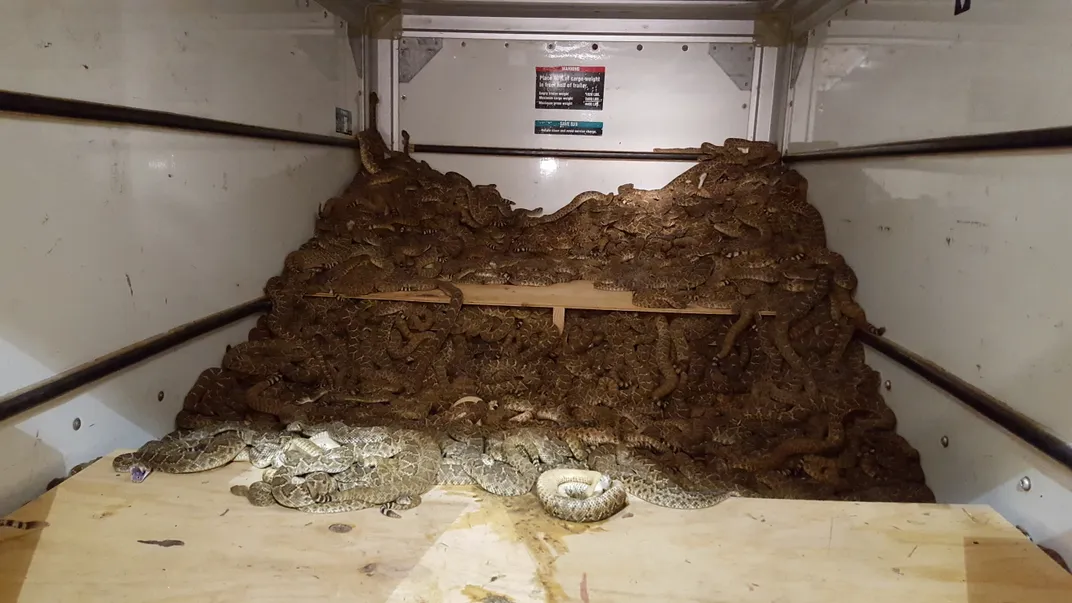Controversial Texas Rattlesnake Roundup Nets Largest Catch to Date
One of the world’s largest rattlesnake roundup bagged nearly 25,000 pounds of rattlers this year
/https://tf-cmsv2-smithsonianmag-media.s3.amazonaws.com/filer/cc/37/cc371622-1f21-4894-952f-b33bd20b6256/20160310_184416.jpg)
As towns go, Sweetwater, Texas is fairly small, with roughly 11,000 residents. But there’s one thing the area has a lot of: diamondback rattlesnakes. Every March for the last 58 years, tens of thousands of visitors have descended on the small town for the annual Rattlesnake Roundup. This year, the event outdid itself, bagging a record 24,262 pounds of wriggling rattlers.
Organized by the Sweetwater Junior Chamber of commerce, or “Jaycees,” the rattlesnake roundup began in as a way to curb rattlesnake populations during the late 1950s. At the time, local doctors were treating 50 people a year for snakebites and local cattle were constantly in danger of dying of suffocation from being bit on the nose, James Joiner reports for the Daily Beast.
But what began as a giant, community-wide rattlesnake cull eventually grew into a kind of county fair. In the years since, the Rattlesnake Roundup has become a hugely popular event, drawing more than 25,000 visitors and millions of dollars in revenue to Sweetwater each spring.
Over the course of four days, thousands of snakes are put on display in snake pits, butchered for meat, and sold to bidders who will turn their skins into everything from boots to belts to watch bands. Even the venom is collected and sold for research.
After the massive haul this year, there is some concern that the snakes not purchased will simply be let loose, reports Oliver Milman for The Guardian. Yet the Jaycees spokesperson Rob McCann disagrees: “There’s always a market for snakes,” he tells Milman. “There will be nothing left over, they will be processed for meat or made into wallets.”
While the previous record for most snakes caught for the Sweetwater roundup was 18,000 pounds in 1982, a typical year’s haul is usually about 4,000 pounds, Alecea Rush reports for KTXS News. Locals attribute this year’s catch to recent heavy rains.
“We had a lot more water in the year and that makes all our other little animals … bigger and better, and then the snakes are catching them too and it makes them a lot [healthier],” snake handler Terry “Hollywood” Armstrong tells Rush.

Unsurprisingly, the bloody tradition has its critics, many of whom argue that it decimates rattlesnake populations instead of controlling them. Animal rights activists and some herpetologists not only argue that the lack of rattlesnake catch limits have a negative impact on rattlesnake populations and that some methods used to catch them, like pouring gasoline into their dens, is inhumane and harmful to the environment, Milman reports.
"It's about money," local herpetologist Michael Price told Brandon Mulder for the Midland Reporter-Telegram last year. "It's become such a tradition, and it brings in a tremendous amount of money to the community. That's my biggest issue; it's not about population control, and it's not about safety. It's about money, and it is what it is."
In recent years, animal rights activists have tried to ban the controversial gasoline corralling technique, with little luck. The Texas Parks and Wildlife department nearly banned the technique in 2013, and officials are meeting again to discuss a possible ban this May. But regardless of whether the gasoline method is banned, the roundup’s defenders say they’ll stand behind the event.
“We’re not cutting the population any,” McCann told Mulder last year. “I’ve been hunting the same dens for 25 years—the exact same dens. I get from 10 to 20 every year from the same dens.”